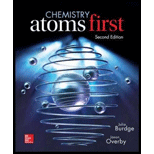
Concept explainers
(a)
Interpretation:
The molar masses of molecules are given by using chemical formula to be calculated.
Concept introduction:
Molar mass is also known as molecular weight, which is the sum of the total mass in grams of all the atoms that present in a particular molecule. If we know the formula of a compound then we can easily determine the compound’s molar mass. We know that a formula consists of atoms and it is important to count atoms carefully, especially in compounds with polyatomic ions enclosed in parentheses.
(b)
Interpretation:
The molar masses of molecules are given by using chemical formula to be calculated.
Concept introduction:
Molar mass is also known as molecular weight, which is the sum of the total mass in grams of all the atoms that present in a particular molecule. If we know the formula of a compound then we can easily determine the compound’s molar mass. We know that a formula consists of atoms and it is important to count atoms carefully, especially in compounds with polyatomic ions enclosed in parentheses.
(c)
Interpretation:
The molar masses of molecules are given by using chemical formula to be calculated.
Concept introduction:
Molar mass is also known as molecular weight, which is the sum of the total mass in grams of all the atoms that present in a particular molecule. If we know the formula of a compound then we can easily determine the compound’s molar mass. We know that a formula consists of atoms and it is important to count atoms carefully, especially in compounds with polyatomic ions enclosed in parentheses.
(d)
Interpretation:
The molar masses of molecules are given by using chemical formula to be calculated.
Concept introduction:
Molar mass is also known as molecular weight, which is the sum of the total mass in grams of all the atoms that present in a particular molecule. If we know the formula of a compound then we can easily determine the compound’s molar mass. We know that a formula consists of atoms and it is important to count atoms carefully, especially in compounds with polyatomic ions enclosed in parentheses.
(e)
Interpretation:
The molar masses of molecules are given by using chemical formula to be calculated.
Concept introduction:
Molar mass is also known as molecular weight, which is the sum of the total mass in grams of all the atoms that present in a particular molecule. If we know the formula of a compound then we can easily determine the compound’s molar mass. We know that a formula consists of atoms and it is important to count atoms carefully, especially in compounds with polyatomic ions enclosed in parentheses.
(f)
Interpretation:
The molar masses of molecules are given by using chemical formula to be calculated.
Concept introduction:
Molar mass is also known as molecular weight, which is the sum of the total mass in grams of all the atoms that present in a particular molecule. If we know the formula of a compound then we can easily determine the compound’s molar mass. We know that a formula consists of atoms and it is important to count atoms carefully, especially in compounds with polyatomic ions enclosed in parentheses.
Want to see the full answer?
Check out a sample textbook solution
Chapter 5 Solutions
Chemistry: Atoms First
- The structure of one of the bases in DNA, adenine, is shown here. Which represents the greater mass: 40.0 g of adenine or 3.0 1023 molecules of the compound?arrow_forwardChlorine exists mainly as two isotopes, 37Cl and 33Cl. Which is more abundant? How do you know?arrow_forwardNitrogen fixation in the root nodules of peas and other legumes occurs with a reaction involving a molybdenum-containing enzyme named nitrogenase. This enzyme contains two Mo atoms per molecule and is 0.0872% Mo by mass. Calculate the molar mass of the enzyme.arrow_forward
- There are 12.6 grams of sugar. With the molecular formula C12H22O11, what is the molar mass of this compund?arrow_forwardWhat is the molar mass of nitroglycerin, C3H5(NO3)3?arrow_forwardThe molecular formula of allicin, the compound responsiblefor the characteristic smell of garlic, is C6H10OS2. (a) Whatis the molar mass of allicin?arrow_forward
- What is the mass, in grams, of 9.47×1024 molecules of methanol (CH3OH)?arrow_forwardThe chemical formula of lysine (a building block of proteins) is C6H14N2O2. Given that the formula mass of lysine is 146.19 amu, what is the % (m/m) composition of N in lysine?arrow_forwardCalculate the mass in grams of 1.35 mol of a) titanium white, TiO2 , used as a paint pigment. b) sucralose, C12H19O8Cl3 , the active ingredient in the artificial sweetener, SplendaTM c) strychnine, C21H22N2O present in a rat poisonarrow_forward
- The molar mass of caffeine is 194.19 g. Is the molecularformula of caffeine C4H5N2O or C8H10N4O2?arrow_forwardCalculate the mass in grams of 2.688 mol of a. chlorophyll, C55H72N4O5Mg, responsible for the green color of leaves. b. sorbitol, C9H14O6 an artificial sweetenerarrow_forwardWhat is the mass in grams of 0.600 mol of glucose, C6H12O6?arrow_forward

 ChemistryChemistryISBN:9781305957404Author:Steven S. Zumdahl, Susan A. Zumdahl, Donald J. DeCostePublisher:Cengage Learning
ChemistryChemistryISBN:9781305957404Author:Steven S. Zumdahl, Susan A. Zumdahl, Donald J. DeCostePublisher:Cengage Learning Chemistry: An Atoms First ApproachChemistryISBN:9781305079243Author:Steven S. Zumdahl, Susan A. ZumdahlPublisher:Cengage Learning
Chemistry: An Atoms First ApproachChemistryISBN:9781305079243Author:Steven S. Zumdahl, Susan A. ZumdahlPublisher:Cengage Learning Chemistry & Chemical ReactivityChemistryISBN:9781337399074Author:John C. Kotz, Paul M. Treichel, John Townsend, David TreichelPublisher:Cengage Learning
Chemistry & Chemical ReactivityChemistryISBN:9781337399074Author:John C. Kotz, Paul M. Treichel, John Townsend, David TreichelPublisher:Cengage Learning Chemistry & Chemical ReactivityChemistryISBN:9781133949640Author:John C. Kotz, Paul M. Treichel, John Townsend, David TreichelPublisher:Cengage Learning
Chemistry & Chemical ReactivityChemistryISBN:9781133949640Author:John C. Kotz, Paul M. Treichel, John Townsend, David TreichelPublisher:Cengage Learning Chemistry: The Molecular ScienceChemistryISBN:9781285199047Author:John W. Moore, Conrad L. StanitskiPublisher:Cengage Learning
Chemistry: The Molecular ScienceChemistryISBN:9781285199047Author:John W. Moore, Conrad L. StanitskiPublisher:Cengage Learning





